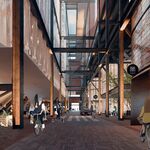11th
Senior Member
We just need a better system to inform pedestrian of different set ups.I asked the VisionZerro a couple of questions, their reply may interest others.
1. Pedestrian Head Start. Currently the standard practice is to add pedestrian head start phases to all feasible intersections across the City (some operations do not permit a head start signal, such as advance protected left turns) and it is being done during scheduled corridor signal timing reviews. Corridors in the City are regularly reviewed for timing and during this time these head start phases are being introduced. As changes to one signal can impact the entire sequence of signals in the vicinity it is best to make these changes when it can be applied across a larger geographic area.
2. Pedestrian actuated signals. For your second point the pedestrian actuated signals are typically at locations were a lower order road meets a higher order road, where the lower order road does not have sustained volume to warrant non-actuated operation. This assessment is done by our traffic signals group to determine the operation of each signal. If you have precise locations in mind that you think could benefit from a signal operation modification I would recommend emailing 311@toronto.ca with the location information or filling out an online service request here: https://www.toronto.ca/home/311-tor...s-sidewalks-and-traffic-safety/traffic-safety. Requesting an assessment through these channels will provide you with a reference number, which will make future follow up easier to track.
Their answer in #1 makes perfect sense, I just wish they would 'get on with it". I am not as satisfied with their policy in #2 as I think they base the 'sustained volume' on traffic and not on traffic and pedestrians. As a pedestrian, I find it confusing to be walking along a street where at some lights I need do nothing except wait for a pedestrian signal to flash while at others I need to press the button.
UPDATE: The VisionZero folk just told me that "I can confirm that the turning movement counts that are collected at intersections by our operations team do include motor vehicles as well as people walking and biking."
On one extreme, this is what you might see in Japan:
Big sign next to the pedestrian signals "Push button set up (to cross)", and the wordy sign to the bottom which basically says (pedestrians) to obey your signal, since pedestrian and vehicle go phases may not be concurrent..










/https://www.thestar.com/content/dam/thestar/news/gta/2022/04/01/our-most-dangerous-streets-huge-new-collision-database-points-to-torontos-postwar-suburbs/_1_main_markham_and_ellesmere.jpg)
/https://www.thestar.com/content/dam/thestar/news/gta/2022/04/01/driver-who-killed-two-pedestrians-and-self-in-etobicoke-crash-had-just-left-scene-of-other-collision-police-say/lakeshore_west_collision_2.jpg)
